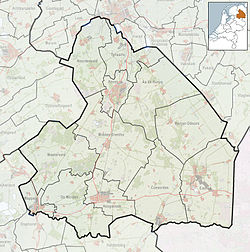Nieuw-Buinen
Nieuw-Buinen | |
|---|---|
 Aerial view on Nieuw-Buinen | |
Location of the village in the province of Drenthe | |
| Coordinates: 52°58′N 6°57′E / 52.967°N 6.950°E | |
| Country | Netherlands |
| Province | Drenthe |
| Municipality | Borger-Odoorn |
| Established | 1823 |
| Area | |
• Total | 23.03 km2 (8.89 sq mi) |
| Elevation | 8 m (26 ft) |
| Population (2021)[1] | |
• Total | 4,865 |
| • Density | 210/km2 (550/sq mi) |
| Time zone | UTC+1 (CET) |
| • Summer (DST) | UTC+2 (CEST) |
| Postal code | 9521[1] |
| Dialing code | 0599 |
Nieuw-Buinen is a village in the Dutch province of Drenthe. It is a part of the municipality of Borger-Odoorn, and lies about 21 kilometres (13 mi) north of Emmen.
The village was first mentioned in 1840 as Nieuw-Buinen. It is a peat excavation village which was founded in 1823. Nieuw (new) has been added to distinguish between Buinen.[3][4] The double canal was dug from Stadskanaal to excavate the peat in the area. In 1838, a glass factory opened in Nieuw-Buinen and was followed by another glass factory in 1840. In 1899, a potato starch factory was added.[4]
The glass industry played a big part in the development and growth of the village. Most of the skilled labourers were brought in from Germany.[5] In 1936 and 1938 takeovers took place and both factories became part of the Vereenigde Glasfabrieken (United Glassworks), leading to the closure of one of the factories in 1938. In 1967 the second factory closed as a result of dwindling sales, with glass packaging being replaced by cardboard and plastics.[6] In remembrance to the role the glassworks played, a statue, "de Glasblazer" ("the Glassblower"), was unveiled and placed on the Noorderdiep in 1974.
Nieuw-Buinen was home to 367 people in 1840.[7] The Dutch Reformed church was built in 1853 in neoclassic style and has an open tower. It was extended in 1904. Villa Flora was built between 1877 and 1879 by the owner of the glass factory. It is named after a cast iron statue of Flora, the goddess of spring.[4]
Gallery
[edit]-
Dutch Reformed church
-
Villa Flora
-
Villa in Nieuw-Buinen
-
Gas station in Nieuw-Buinen
-
Statue "de Glasblazer"
References
[edit]- ^ a b c "Kerncijfers wijken en buurten 2021". Central Bureau of Statistics. Retrieved 11 April 2022.
- ^ "Postcodetool for 9521AA". Actueel Hoogtebestand Nederland (in Dutch). Het Waterschapshuis. Retrieved 11 April 2022.
- ^ "Nieuw-Buinen - (geografische naam)". Etymologiebank (in Dutch). Retrieved 11 April 2022.
- ^ a b c Ronald Stenvert (2001). Nieuw-Buinen (in Dutch). Zwolle: Waanders. p. 61. ISBN 90 400 9454 3. Retrieved 11 April 2022.
- ^ Voerman, Jan Francinus (2001). Verstedelijking en migratie in het Oost-Groningse veengebied 1800-1940 (in Dutch). S.n. pp. 52–53. ISBN 9789023237600.
- ^ "Nieuw Buinen: een glashelder verhaal". De verhalen van Groningen (in Dutch). Retrieved 2022-05-31.
- ^ "Nieuw-Buinen". Plaatsengids (in Dutch). Retrieved 11 April 2022.
External links
[edit] Media related to Nieuw-Buinen at Wikimedia Commons
Media related to Nieuw-Buinen at Wikimedia Commons







